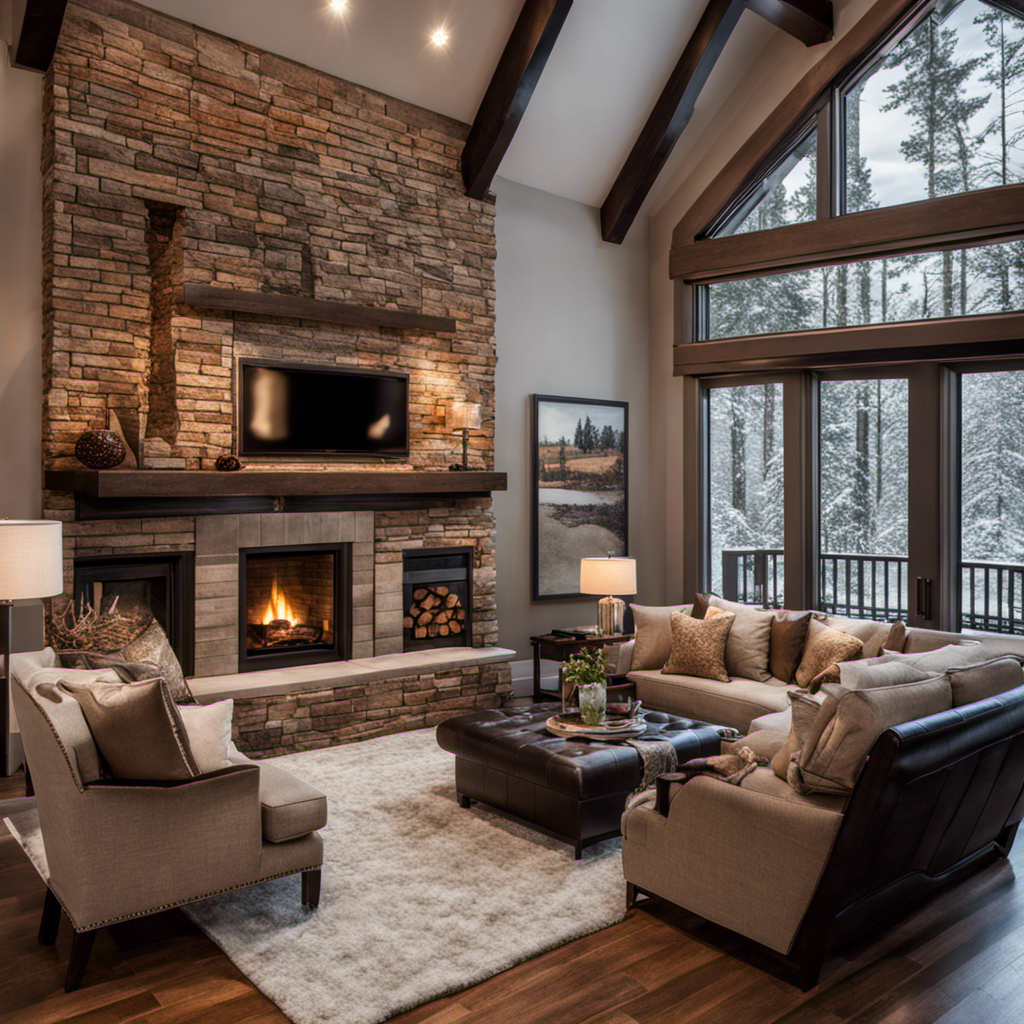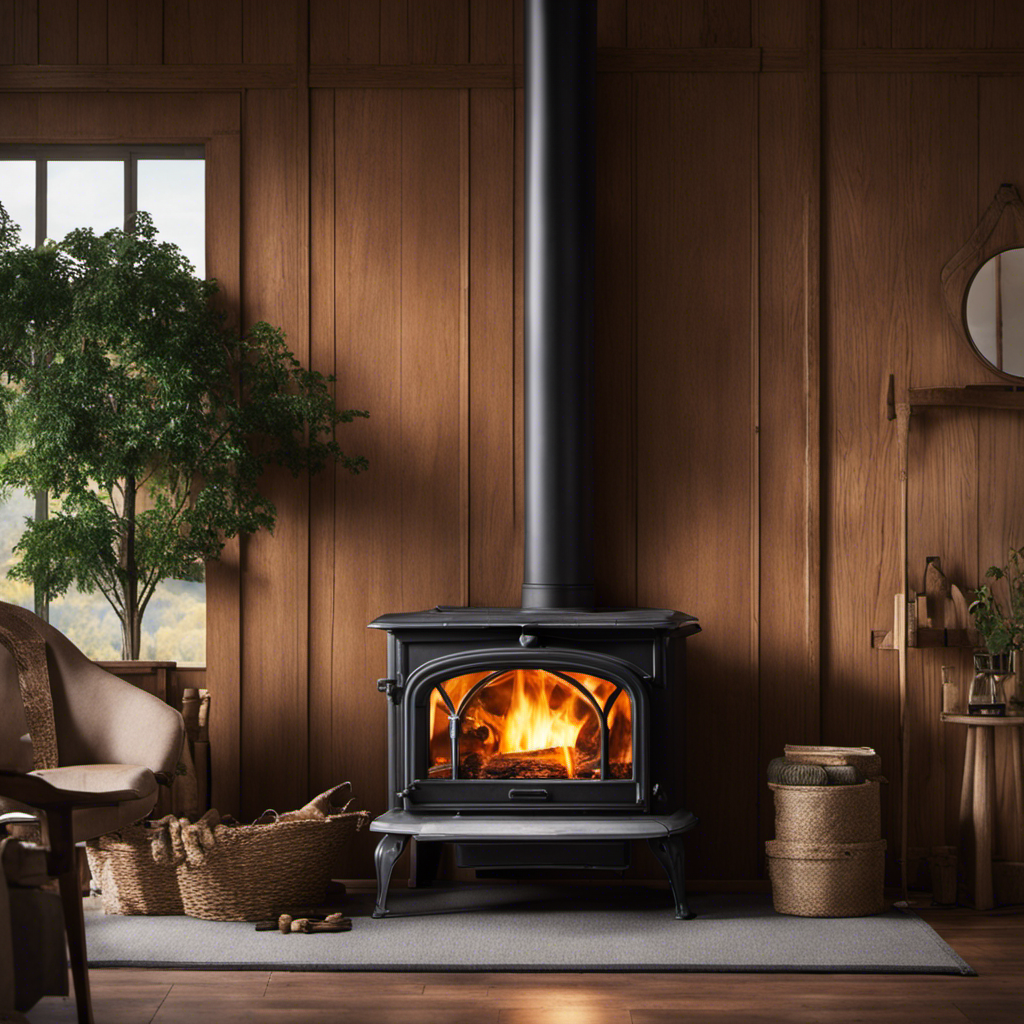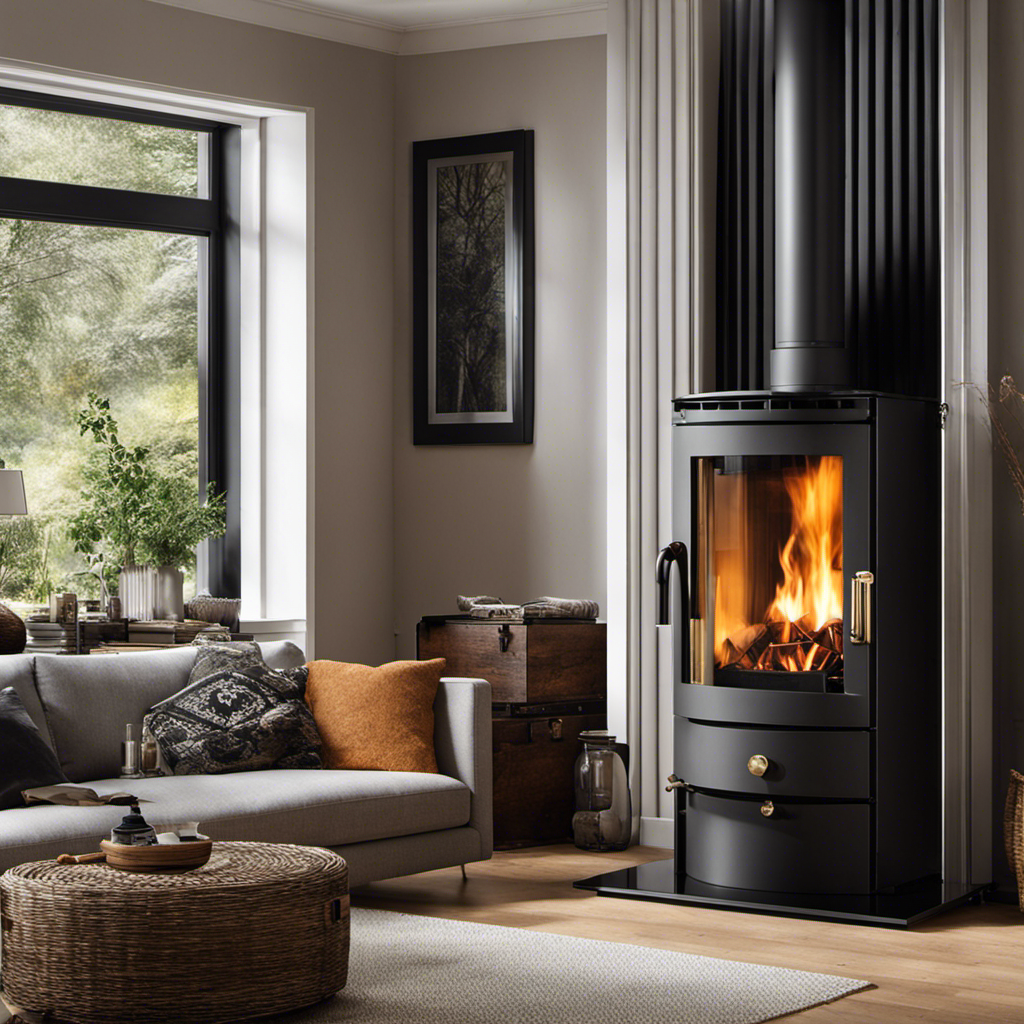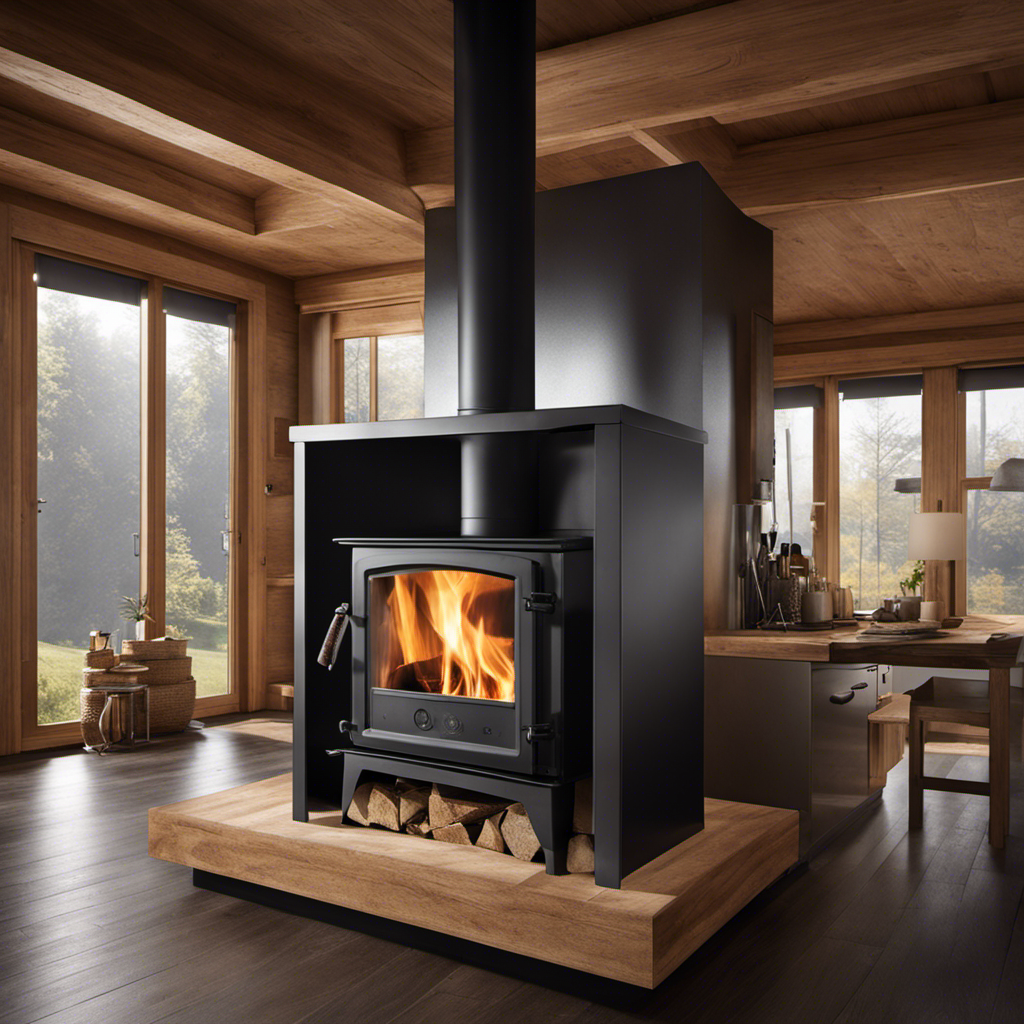Wood Stove
How To Clean Soot From Wood Stove

I thought I had mastered the art of keeping wood stoves in top condition, until I met my match: soot. This relentless adversary seemed invincible, but then I discovered the secrets to obtaining a spotless wood stove.
In this guide, I’ll share my tried and tested methods for banishing soot from your beloved wood stove. Get ready to restore its pristine condition and ensure cozy, efficient warmth for years to come.
Let’s dive in and reclaim your wood stove from the clutches of soot!
Key Takeaways
- Using the right cleaning solutions and protective gloves is crucial for safe and effective removal of soot and creosote buildup.
- Preparing the wood stove for cleaning includes removing debris and ashes, taking safety precautions, and maintaining regular cleaning to ensure optimal performance.
- Removing loose soot and ash involves sweeping, vacuuming, and wiping down surfaces to create a clean surface for thorough cleaning.
- Deep cleaning the wood stove requires removing grates, scrubbing them with a vinegar and water mixture, and thoroughly rinsing and drying them before placing them back.
Necessary Tools and Materials
I need a few necessary tools and materials to clean the soot from my wood stove.
Firstly, I’ll need some cleaning solutions specifically designed for removing soot and creosote buildup. These solutions are effective in breaking down the stubborn residue and making it easier to remove.
Additionally, I’ll make sure to have a pair of protective gloves to keep my hands safe from any chemicals or dirt that may be present during the cleaning process. These gloves will provide a barrier between my skin and the cleaning agents, preventing any potential harm.
It’s important to have the right tools and materials to ensure a thorough and safe cleaning of my wood stove. With the proper cleaning solutions and protective gloves, I can achieve just that.
Preparing the Wood Stove for Cleaning
The first step in preparing the wood stove for cleaning is to remove any debris or ashes from the interior. Before starting this process, it’s important to take some precautions to ensure safety.
First, make sure the stove is completely cool. Wear protective gloves and a mask to avoid any contact with the soot or harmful particles.
Once the stove is cool, use a shovel or brush to carefully remove any debris or ashes. It’s crucial to clean the stove regularly to maintain its performance. A buildup of soot and debris can hinder the stove’s efficiency and even pose a fire hazard.
Regular cleaning also helps to prevent any potential blockages in the flue, ensuring proper ventilation. By following these steps and taking the necessary precautions, you can keep your wood stove clean and functioning optimally.
Removing Loose Soot and Ash
To effectively clean the wood stove, I’ll start by carefully sweeping out the loose soot and ash using a brush and dustpan. This step is crucial in preparing the stove for a thorough cleaning. By removing the loose debris, we can create a clean surface to work with.
Once the sweeping is complete, it’s important to take the next step of vacuuming the remaining soot particles. Using a vacuum with a brush attachment, I can effectively remove any lingering soot from the stove’s interior.
After vacuuming, I’ll move on to wiping down the surfaces with a damp cloth. This will help eliminate any remaining dust and soot residue. Remember to use a cloth that’s slightly damp, not wet, to avoid introducing excess moisture into the stove.
Deep Cleaning the Wood Stove
After carefully sweeping out the loose soot and ash, I can now move on to deep cleaning the wood stove by removing the grates and scrubbing them with a mixture of vinegar and water.
Before starting this process, it’s crucial to take some safety precautions. First, make sure the wood stove is completely cool to avoid any burns. It’s also recommended to wear gloves and protective eyewear to protect yourself from any potential injuries.
To remove stubborn soot, mix equal parts vinegar and water in a spray bottle. Spray this solution onto the grates and let it sit for a few minutes to loosen the grime. Then, using a scrub brush, gently scrub the grates to remove the remaining soot. Rinse the grates thoroughly with water and dry them before placing them back into the wood stove.
Maintaining a Clean Wood Stove for Future Use
I usually clean my wood stove thoroughly after each use to ensure it stays in good condition for future use. Maintaining a clean wood stove is essential for its longevity and efficient performance. One of the primary concerns in wood stove maintenance is preventing soot buildup.
Soot is a result of incomplete combustion and can accumulate on the interior surfaces of the stove, affecting its efficiency and potentially causing safety hazards. To prevent soot buildup, regular cleaning is necessary.
Start by removing ashes and debris from the stove. Then, use a stiff brush or scraper to remove any soot deposits from the inside walls and grates. Finally, vacuum or sweep the stove’s surrounding area to eliminate any loose soot particles.
Regular maintenance and cleaning will ensure your wood stove stays in top-notch condition for years to come.
Conclusion
Cleaning soot from a wood stove doesn’t have to be a daunting task. By following these simple steps and using the right tools, you can easily remove the buildup and maintain a clean stove for future use.
Remember, a clean stove not only improves its efficiency but also ensures a cozy and enjoyable experience. So, grab your cleaning materials and get ready to banish that soot, because a spotless wood stove awaits you!
Growing up surrounded by the vast beauty of nature, Sierra was always drawn to the call of the wild. While others sought the comfort of the familiar, she ventured out, embracing the unpredictable and finding stories in the heartbeat of nature.
At the epicenter of every remarkable venture lies a dynamic team—a fusion of diverse talents, visions, and passions. The essence of Best Small Wood Stoves is crafted and refined by such a trio: Sierra, Logan, and Terra. Their collective expertise has transformed the platform into a leading authority on small wood stoves, radiating warmth and knowledge in equal measure.
Wood Stove
What Is The Fine For Burning Wood Stove During A Stage 2 Burn Ban

Hello there! It seems like you’re interested in learning about the implications of using a wood stove during a stage 2 burn ban, correct? Well, you’re in the right spot.
In this article, I’ll be diving into the nitty-gritty of understanding these burn bans, the regulations surrounding them, and the factors that determine the fines.
I’ll even provide some examples of wood burning offenses and suggest alternatives to wood stoves to help you avoid any penalties.
So, let’s get started, shall we?
Key Takeaways
- Burning wood during a Stage 2 burn ban can result in fines and penalties.
- The severity of the offense and previous compliance history are factors that determine the fine amount.
- Wood burning during a burn ban contributes to air pollution and negatively affects air quality.
- Switching to alternative heating methods such as electric or gas furnaces can help avoid penalties and minimize environmental impact.
Understanding Stage 2 Burn Bans
I can’t believe how many people are still unaware of the restrictions imposed during Stage 2 burn bans.
It’s crucial to understand the economic impact and health risks associated with violating these bans.
First and foremost, burning wood during a Stage 2 burn ban can have severe economic consequences. The increased air pollution caused by wood burning can lead to higher healthcare costs, reduced crop yields, and detrimental effects on tourism and outdoor activities.
Moreover, the health risks posed by wood smoke are significant. Fine particulate matter released during wood burning can worsen respiratory conditions, such as asthma and bronchitis, and contribute to heart disease and premature death.
It’s essential for everyone to be informed about these restrictions to protect both our economy and our health.
Regulations and Enforcement
Although regulations and enforcement of burn bans are in place, some individuals continue to burn wood during Stage 2 bans, putting our health and economy at risk. It’s crucial to emphasize the importance of regulatory compliance and the impact it has on our air quality.
The burning of wood during Stage 2 bans releases harmful pollutants into the air, contributing to poor air quality and posing serious health risks, especially for those with respiratory conditions. Compliance with burn bans is essential to protect the well-being of our community and ensure the preservation of our environment.
Moreover, non-compliance can result in fines and penalties, which can have significant economic consequences. By adhering to burn bans, we can collectively work towards improving air quality and safeguarding our health and economy.
Factors That Determine Fines
Burning wood during a Stage 2 burn ban can result in fines. These fines are determined based on various factors such as the severity of the violation and the individual’s previous compliance history. The calculation of fines for burning wood during a Stage 2 burn ban is a complex process that takes into account several key factors.
Firstly, the severity of the violation plays a significant role in determining the amount of the fine. If the violation is deemed to be more severe, the fine will be higher. This means that individuals who are found to have burned wood during a Stage 2 burn ban in a more egregious manner may face steeper fines.
Additionally, an individual’s previous compliance history is also taken into consideration when determining the fines. Those with a history of non-compliance may face more severe fines. This is because repeat offenders are seen as a higher risk and may require stronger penalties to deter further violations.
It’s important to note that the legal consequences of burning wood during a Stage 2 burn ban can be significant. Fines are not only meant to punish individuals but also to serve as a deterrent to prevent further violations. By imposing financial penalties, authorities hope to discourage people from disregarding burn bans and help protect public health and the environment.
Examples of Wood Burning Offenses
I’ve heard of instances where individuals have been fined for burning wood during a Stage 2 burn ban. It’s important to understand the consequences of illegal burning and the potential environmental impact it can have.
Burning wood during a burn ban is considered illegal because it can contribute to air pollution and negatively affect air quality. When wood is burned, it releases harmful pollutants such as carbon monoxide, nitrogen oxides, and particulate matter into the atmosphere. These pollutants can have detrimental effects on human health and the environment.
To discourage illegal burning, fines are imposed on individuals who violate burn bans. These fines can vary depending on the jurisdiction and the severity of the offense.
It’s crucial to abide by burn bans and find alternative methods for heating and energy sources during these periods to minimize the environmental impact and protect public health.
Avoiding Penalties: Alternatives to Wood Stoves
There are several viable options for reducing penalties associated with burning wood stoves. One option is switching to alternative heating methods like electric or gas furnaces.
By adopting electric heating options, homeowners can enjoy a clean and efficient source of heat without the emissions produced by wood stoves. Electric furnaces offer precise temperature control and are easy to install and maintain.
On the other hand, gas-powered heating alternatives provide a reliable and cost-effective solution. Gas furnaces are known for their high energy efficiency and can be powered by natural gas or propane. They offer quick and consistent heat, making them a popular choice among homeowners.
Frequently Asked Questions
How Long Does a Stage 2 Burn Ban Typically Last?
A stage 2 burn ban typically lasts for several days to a week. During this time, the burning of wood stoves is prohibited to reduce air pollution and improve air quality in the area.
Can I Still Use My Wood Stove During a Stage 2 Burn Ban if It Is My Only Source of Heat?
I understand the concern about using a wood stove as your only source of heat during a stage 2 burn ban. However, it’s important to explore alternative heating options to ensure compliance with the ban and avoid any potential fines.
Are There Any Exceptions to the Fines for Burning Wood Stoves During a Stage 2 Burn Ban?
During a Stage 2 burn ban, fines for burning wood stoves apply. However, there may be exceptions to these fines. It’s important to explore alternative heating options to comply with the ban and avoid penalties.
What Actions Can Be Taken if I Suspect Someone Is Burning Wood Illegally During a Stage 2 Burn Ban?
If I suspect someone is illegally burning wood during a Stage 2 burn ban, I can take appropriate actions by reporting the incident to the local authorities. Penalties may vary depending on the jurisdiction.
What Are the Potential Health Risks Associated With Burning Wood During a Stage 2 Burn Ban?
Burning wood during a Stage 2 burn ban can pose potential health risks due to increased air pollution. It’s important to be aware of the consequences and prioritize the well-being of our community.
Conclusion
In conclusion, understanding the regulations and enforcement surrounding wood burning during a stage 2 burn ban is essential to avoid penalties.
One interesting statistic to note is that fines for violating these bans can range from $200 to $1,000, depending on various factors such as previous offenses and the severity of the violation.
By exploring alternative heating options, we can contribute to cleaner air quality and help protect our environment.
Stay informed and make responsible choices to avoid fines and promote a healthier community.
Growing up surrounded by the vast beauty of nature, Sierra was always drawn to the call of the wild. While others sought the comfort of the familiar, she ventured out, embracing the unpredictable and finding stories in the heartbeat of nature.
At the epicenter of every remarkable venture lies a dynamic team—a fusion of diverse talents, visions, and passions. The essence of Best Small Wood Stoves is crafted and refined by such a trio: Sierra, Logan, and Terra. Their collective expertise has transformed the platform into a leading authority on small wood stoves, radiating warmth and knowledge in equal measure.
Wood Stove
How Much Does It Cost To Build A Fireplace With A Wood Stove Insert

To be completely honest, installing a fireplace with a wood stove insert can end up being quite expensive. However, before completely ruling out the idea, let’s delve deeper into the details.
In this article, I’ll delve into the upfront expenses, material costs, installation fees, and operational expenses associated with this heating option.
Plus, I’ll explore whether the long-term savings make it worth it.
So, if you’re curious about the true price tag of cozy warmth, keep reading.
Key Takeaways
- Building a fireplace with a wood stove insert can save money on heating bills and reduce environmental impact.
- Upfront costs vary but can be offset by long-term savings, and higher quality materials offer better performance and durability.
- Installation costs depend on project complexity, materials used, and location, and professional installation ensures optimal energy efficiency and cost savings.
- Operational expenses include fuel costs and regular maintenance, and wood stove inserts offer long-term savings through lower energy bills and a lower environmental impact.
Initial Investment: What Are the Upfront Costs of Building a Fireplace With a Wood Stove Insert
I can’t believe how much money I saved by researching the upfront costs of building a fireplace with a wood stove insert.
When it comes to energy efficiency, a wood stove insert is a great option. It can efficiently heat your home, using less fuel compared to traditional fireplaces. This not only saves you money on heating bills, but also reduces your environmental impact by decreasing the amount of fuel needed.
Additionally, wood stove inserts are designed to burn wood more efficiently, minimizing the release of harmful emissions. By investing in a fireplace with a wood stove insert, you not only save money in the long run but also contribute to a greener and more sustainable environment.
Now, let’s move on to the next topic and discuss the material expenses for building a fireplace with a wood stove insert.
Material Expenses: How Much Do the Materials for the Fireplace and Wood Stove Insert Cost
The cost of materials for the fireplace and wood stove insert can vary, but on average, it ranges from $1,500 to $3,000. When it comes to building a fireplace with a wood stove insert, the quality of materials plays a significant role in determining the overall cost. Higher quality materials tend to be more expensive, but they also offer better performance and durability. Cheaper alternatives may be available, but they may not provide the same level of efficiency and longevity. It is important to consider the long-term benefits and potential savings when choosing materials. To provide a clearer picture, here is a comparison table showcasing the impact of material quality on cost:
| Material Quality | Cost |
|---|---|
| High-Quality | $3,000 |
| Medium-Quality | $2,000 |
| Low-Quality | $1,500 |
Considering alternative options, it is possible to find cheaper materials, but they may compromise on quality and performance. It is advisable to consult with professionals to ensure the materials chosen meet safety standards and provide the desired functionality.
Installation Costs: What Are the Expenses Involved in Hiring Professionals to Install the Fireplace and Wood Stove Insert
When hiring professionals for the installation of a fireplace and wood stove insert, it’s important to consider the expenses involved and compare prices from different contractors. The installation costs can vary depending on factors such as the complexity of the project, the type of materials used, and the location of your home. It’s crucial to get multiple quotes and compare them to ensure you’re getting the best value for your money.
In addition to the expenses, it’s also important to consider the installation timeline. Some contractors may be able to complete the installation quickly, while others may have a longer waiting period. It’s essential to discuss the timeline with potential contractors to ensure it aligns with your needs and expectations.
Furthermore, energy efficiency is another important factor to consider. A well-installed fireplace and wood stove insert can provide significant energy savings over time. It’s worth investing in a high-quality product and professional installation to ensure optimal energy efficiency and long-term cost savings.
Overall, when hiring professionals for the installation of a fireplace and wood stove insert, it’s crucial to consider the expenses, installation timeline, and energy efficiency comparison. This will help you make an informed decision and ensure that you get the best value for your money.
Operational Expenses: How Much Does It Cost to Use a Wood Stove Insert, Including Fuel and Maintenance
Since I use a wood stove insert, I am curious about how much it costs to operate, including fuel and maintenance. Fuel efficiency and regular maintenance are crucial factors that can significantly impact the overall cost of using a wood stove insert. Let’s take a closer look at the expenses involved:
| Expenses | Average Cost |
|---|---|
| Fuel (wood) | $200 – $500 |
| Maintenance | $100 – $300 |
| Total | $300 – $800 |
Fuel efficiency plays a significant role in determining the cost of operating a wood stove insert. The type and quality of wood used can affect the burn rate and heat output. Seasoned hardwood is recommended for optimal performance and efficiency. Regular maintenance, such as chimney cleaning and inspections, ensures safe and efficient operation while preventing costly repairs.
Now, let’s explore the long-term savings. Are there any cost savings associated with using a wood stove insert compared to other heating options?
Long-Term Savings: Are There Any Cost Savings Associated With Using a Wood Stove Insert Compared to Other Heating Options?
I believe there can be significant cost savings associated with using a wood stove insert compared to other heating options. Here are some reasons why:
-
Energy Efficiency: Wood stove inserts are known for their high energy efficiency. They’re designed to burn wood more efficiently, which means they produce more heat with less fuel. This can result in lower energy bills and long-term cost savings.
-
Environmental Impact: Wood stove inserts are a more environmentally friendly heating option compared to fossil fuel-based systems. When wood is burned efficiently, it releases fewer emissions and pollutants into the atmosphere. By using a wood stove insert, you can reduce your carbon footprint and contribute to a cleaner environment.
-
Fuel Availability and Cost: Wood is a renewable resource and is often more readily available and less expensive compared to other heating fuels like oil or gas. By using a wood stove insert, you can take advantage of this cost-effective fuel source and potentially save money on heating expenses.
-
Versatility: Wood stove inserts can be used as a supplemental heating source or as the primary heat source for your home. This versatility allows you to control your heating costs based on your specific needs and preferences.
Frequently Asked Questions
Are There Any Safety Precautions or Regulations to Consider When Installing a Fireplace With a Wood Stove Insert?
When installing a fireplace with a wood stove insert, it’s crucial to adhere to safety regulations and take installation precautions. These measures ensure the safety of your home and prevent any potential hazards.
What Is the Average Lifespan of a Wood Stove Insert, and Are There Any Ongoing Maintenance Costs?
The average lifespan of a wood stove insert is around 15-20 years. Ongoing maintenance costs can vary but typically include annual chimney inspections and cleanings, replacement of gaskets, and occasional repairs.
Can a Wood Stove Insert Be Used as the Primary Heat Source for a Home, or Is It More Suitable as a Supplemental Heating Option?
As a primary heat source, a wood stove insert can effectively warm a home. However, it can also serve as a supplemental heating option. Its efficiency and cost-effectiveness make it a popular choice for homeowners.
Are There Any Environmental Benefits to Using a Wood Stove Insert Compared to Other Heating Options?
Using a wood stove insert has environmental benefits like reducing carbon emissions. Compared to other heating options, it’s cost-effective in the long run. It’s a win-win for the planet and your wallet.
How Do the Heating Capabilities of a Wood Stove Insert Compare to Traditional Fireplaces or Electric Heating Options?
The heating capabilities of a wood stove insert are far superior to traditional fireplaces or electric heating options. It provides higher heating efficiency and can save on costs in the long run.
Are There Any Alternatives to Wood Stoves or Fireplaces for Heating a Home During a Power Outage?
There are various heating options during power outages apart from wood stoves or fireplaces. Propane or kerosene heaters provide portable and efficient heat sources. Pellet stoves utilize compressed sawdust as fuel, while gas fireplaces offer a convenient alternative. Additionally, emergency generators combined with electric space heaters can act as effective substitutes.
Conclusion
After analyzing the costs associated with building a fireplace with a wood stove insert, it’s clear that the initial investment and material expenses can be significant. However, the long-term savings and cost benefits of using a wood stove insert make it a worthwhile investment.
Not only does it provide efficient heating, but it also offers the opportunity to reduce utility bills and enjoy the cozy ambiance of a crackling fire.
So, if you’re looking for a cost-effective and sustainable heating option, a wood stove insert is definitely worth considering.
Wood Stove
Why Does My Wood Stove Always Runaway

As someone who owns a wood stove, I have dealt with the annoyance of managing a stove that appears to have a will of its own. It seems to constantly evade control, refusing to remain reliable and provide the necessary warmth.
But fear not! In this article, we’ll delve into the reasons behind this runaway behavior and explore the importance of proper installation, airflow control, chimney maintenance, and more.
Let’s put an end to the wood stove’s wild escapades for good.
Key Takeaways
- Improper installation can lead to overheating, inadequate airflow, and dangerous situations.
- Understanding airflow and draft control ensures efficient wood stove operation and prevents smoke from entering the home.
- Regular chimney inspections and maintenance are necessary to prevent chimney fires and detect potential issues.
- Overloading and overheating can compromise fire safety, so it is important to monitor the wood stove’s temperature and follow manufacturer’s guidelines for capacity.
The Importance of Proper Installation
I think the importance of proper installation can’t be overstated when it comes to preventing runaway wood stove incidents. Common installation mistakes can lead to dangerous situations, such as fires or carbon monoxide leaks.
One of the most common mistakes is improper clearance. Wood stoves need a certain amount of space around them to ensure proper airflow and prevent overheating.
Another mistake is using the wrong type of chimney or flue. It’s essential to choose the right size and material that can handle the heat and exhaust gases.
Signs of improper installation include excessive smoke, soot buildup, or a strong smell of burning. These indicators suggest a problem with the stove’s ventilation or sealing.
To avoid runaway wood stove incidents, it’s crucial to hire a professional installer who can follow the manufacturer’s guidelines and ensure a safe installation.
Understanding Airflow and Draft Control
Having a clear understanding of how to control airflow and draft is essential for ensuring the efficient operation of a wood stove. One key aspect of this understanding is recognizing the role of combustion air intake. This intake provides the necessary oxygen for the combustion process, which is vital for achieving a clean and efficient burn. To help illustrate this concept, let’s take a look at the table below:
| Airflow Setting | Draft Level |
|---|---|
| High | Strong |
| Medium | Moderate |
| Low | Weak |
| Closed | None |
Maintaining a Clean and Functional Chimney
Regularly cleaning and inspecting the chimney is essential for ensuring a clean and functional wood stove operation.
Chimney inspections are important because they help identify and address potential issues before they become major problems. One common chimney problem is the buildup of creosote, a highly flammable substance that can accumulate on the chimney walls. Regular inspections allow for the timely removal of creosote, reducing the risk of chimney fires.
Another common problem is chimney obstruction, which can occur due to the presence of debris or animal nests. Inspections help detect these obstructions and allow for their removal, ensuring proper airflow and preventing smoke from entering the home.
Additionally, inspections can identify structural issues such as cracks or damaged bricks, which can be repaired to maintain the integrity of the chimney.
Avoiding Overloading and Overheating
To avoid overloading and overheating, it’s important to monitor the wood stove’s temperature and not exceed its recommended capacity. This is crucial for fire safety precautions and to ensure the longevity of your wood stove.
Here are some important points to consider:
-
Keep an eye on the temperature gauge: Regularly check the temperature gauge on your wood stove to ensure it remains within the recommended range. This will help you avoid overheating and potential damage to the stove.
-
Follow the manufacturer’s guidelines: Each wood stove has a specific capacity that shouldn’t be exceeded. Make sure to read and follow the manufacturer’s guidelines to prevent overloading and potential accidents.
-
Stick to a regular maintenance routine: Regularly clean and inspect your wood stove to ensure it’s functioning properly. This will help prevent any build-up of creosote or other debris that could increase the risk of overheating.
Tips for Securing Your Wood Stove in Place
I used metal brackets and screws to secure my wood stove in place, ensuring it won’t move or tip over during use. Anchoring methods for wood stoves are crucial for safety and stability.
There are several options available to anchor your wood stove effectively. One method is using floor brackets, which are attached to the stove’s legs and then secured to the floor using screws or bolts. Another option is wall brackets, which are installed on the back of the stove and then anchored into the wall. These brackets provide additional stability and prevent any movement or tipping.
Additionally, floor protection is essential to prevent heat transfer to combustible materials. Common floor protection options for wood stoves include fire-resistant tiles, concrete boards, or a non-combustible hearth pad. These materials create a barrier between the stove and the floor, reducing the risk of fire or damage.
Proper anchoring and floor protection not only ensure the safety of your wood stove but also provide peace of mind during operation.
Frequently Asked Questions
What Are the Signs That Indicate Improper Installation of a Wood Stove?
Improper installation of a wood stove can be indicated by signs such as poor drafting, smoke leakage, and excessive creosote buildup. Proper maintenance and troubleshooting techniques can help identify and address these issues.
How Can I Improve the Airflow and Draft Control in My Wood Stove?
To improve airflow and draft control in my wood stove, I would start by cleaning the chimney and air vents. I could also adjust the damper and check for any obstructions. Troubleshooting common problems is crucial for improving efficiency.
What Are the Common Issues That Can Arise From a Dirty or Malfunctioning Chimney?
Common chimney problems can arise from a dirty or malfunctioning chimney. To clean a chimney, use a chimney brush to remove creosote and soot buildup. Regular maintenance is crucial to prevent potential hazards and ensure proper functioning.
How Can I Prevent Overloading and Overheating of My Wood Stove?
To prevent overloading and overheating of my wood stove, I ensure proper maintenance. By regularly cleaning the chimney, inspecting the stove for damage, and using the appropriate amount of fuel, I can avoid potential hazards.
Are There Any Additional Safety Measures I Should Take to Secure My Wood Stove in Place?
To secure my wood stove in place, I recommend anchoring it properly. This ensures that it won’t run away and provides added safety. Follow the manufacturer’s instructions and use sturdy materials for a secure installation.
Can Voda Fans Be Used on All Types of Wood Stoves?
Can Voda Fans be used on all types of wood stoves? The answer lies in wood stove compatibility. It is crucial to ensure that the Voda Fan you choose is compatible with your specific wood stove model. Checking the manufacturer’s guidelines and specifications is essential to determine if the Voda Fan can be safely and effectively used on your particular wood stove. Always prioritize compatibility to ensure optimal performance and longevity of both your Voda Fan and wood stove.
Conclusion
In conclusion, it seems that my wood stove has a mind of its own and always wants to run away. Despite my best efforts to secure it and maintain it properly, it still manages to break free.
Perhaps it’s just trying to remind me that even in the world of technology and control, nature can still have a rebellious streak.
So, I’ll continue to enjoy the warmth it provides, while keeping a watchful eye on its escape attempts.
Logan’s affair with adventure began in childhood. He hailed from a small town where vast forests bordered one side and endless shores stretched on the other. His days were spent exploring uncharted woods, climbing tall trees, or listening to the tales of old sailors. This early immersion in a world brimming with stories and mysteries became the foundation of his passion for writing.
-

 Wood Stove3 months ago
Wood Stove3 months agoHow To Build A Thermoelectric Generator For A Wood Stove
-

 Wood Stove4 months ago
Wood Stove4 months agoHow To Use Damper And Draft On Wood Stove
-

 Wood Stove4 months ago
Wood Stove4 months agoWhen To Open And Close Damper On Wood Stove
-

 Wood Stove4 months ago
Wood Stove4 months agoHow Far Does Wood Stove Have To Be From Wall
-

 Wood Stove3 months ago
Wood Stove3 months agoHow Does A Circulator Wood Stove Work
-

 Pellet Stoves3 months ago
Pellet Stoves3 months agoWhy Is My Wood Pellet Stove Putting so Much Soot
-

 Wood Stove4 months ago
Wood Stove4 months agoWhat Can I Use As Insulation On Wood Stove Pipes
-

 Pellet Stoves3 months ago
Pellet Stoves3 months agoHow to Make a Pellet Basket for Wood Burning Stoves












